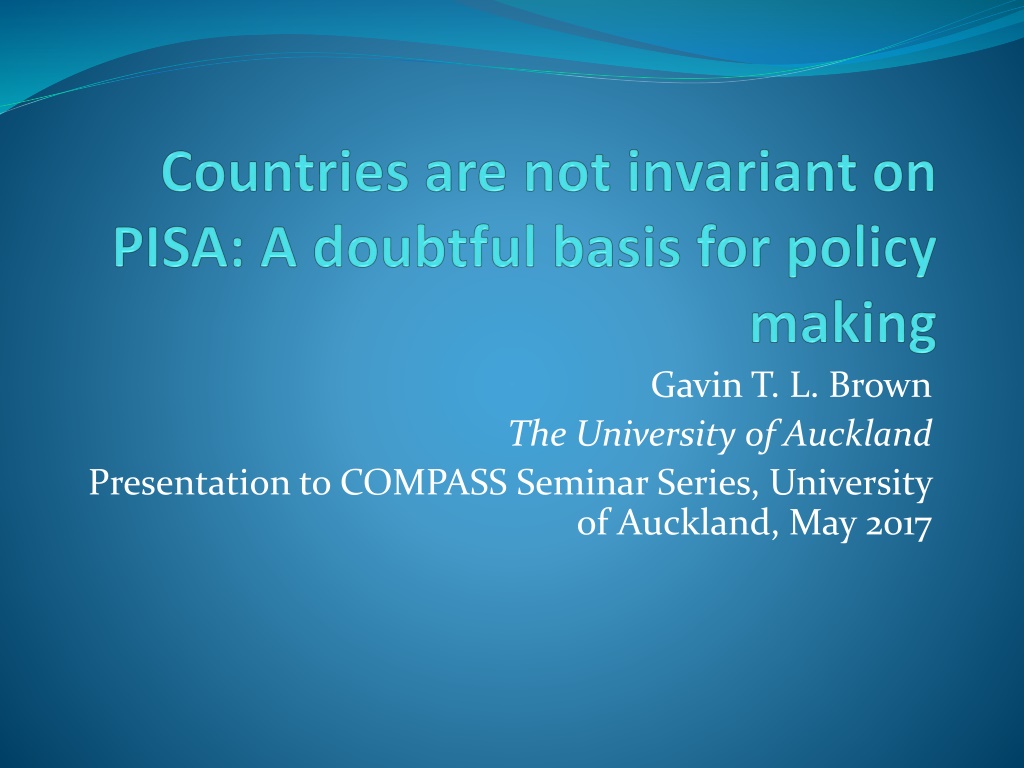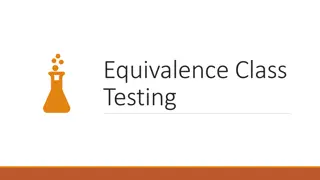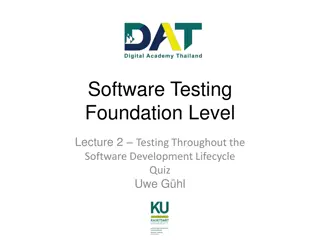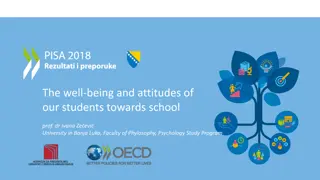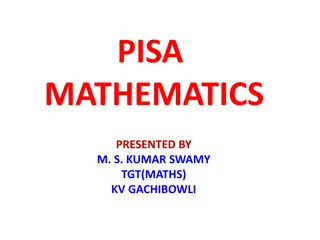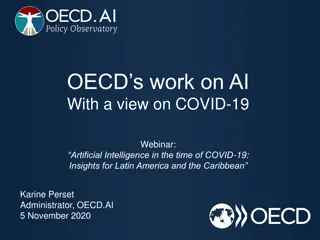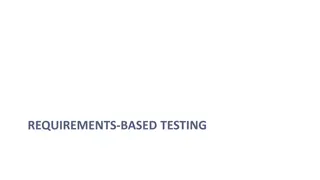Insights into OECD PISA Testing and Impact
Delve into the OECD PISA testing program, aimed at assessing the knowledge and skills of 15-year-old students worldwide. Explore the aims, methods, and impact of PISA testing on education policies and practices globally. Understand the significance of PISA results in shaping educational reforms and fostering international comparability in education systems.
Download Presentation

Please find below an Image/Link to download the presentation.
The content on the website is provided AS IS for your information and personal use only. It may not be sold, licensed, or shared on other websites without obtaining consent from the author.If you encounter any issues during the download, it is possible that the publisher has removed the file from their server.
You are allowed to download the files provided on this website for personal or commercial use, subject to the condition that they are used lawfully. All files are the property of their respective owners.
The content on the website is provided AS IS for your information and personal use only. It may not be sold, licensed, or shared on other websites without obtaining consent from the author.
E N D
Presentation Transcript
Gavin T. L. Brown The University of Auckland Presentation to COMPASS Seminar Series, University of Auckland, May 2017
Aims of PISA A basic profile of knowledge and skills among 15- year-old students. Contextual indicators relating results to student and school characteristics. Trend indicators showing how results change over time. A valuable knowledge base for policy analysis and research.
PISA http://www.pisa.oecd.org/ 55 economies since 2000 3 year cycle 3 subjects: school curriculum + important knowledge and skills needed in adult life. Reading literacy, 2000, 2009 Mathematical literacy, 2003, 2012 Scientific literacy, 2006, 2015 Each subject takes priority in that order typically involve 4,500 and 10,000 students in each country.
Methods Administered internationally by ACER Substantial inter-country, inter-language comparability judgementsand statistical analyses before finalising test forms A total of about seven hours of test items created students take different combinations of test items to a maximum of 2 hours. Pencil-and-paper tests Test items are multiple-choice and constructed response The items are organised in groups based on a passage setting out a real-life situation. background questionnaire 20-30 minutes information about themselves and their homes School principals 20-minute questionnaire about their schools.
Impact of PISA Perception that education is Internationally & globally comparable & equivalent Marketised esp. development of human capital Borrowable lendable across national, cultural borders Example effects: Reforms in various countries Afonsoand Costa (2009) for Portugal, Takayama (2008) for Japan, Rautalin and Alasuutari (2009) for Finland, G ret al. (2012) for Turkey. Simolaet al. (2013) Finland Dobbins and Martens (2012) for France Egelund (2008) Denmark Bieber & Martens (2011) for Switzerland Teltemann, J., & Klieme, E. (2016). The impact of international testing projects on policy and practice. In G. T. L. Brown & L. R. Harris (Eds.), Handbook of Human and Social Conditions in Assessment (pp. 369-386). New York: Routledge.
Adapted for context Language checking Translate-back translate Functional equivalence Curriculum alignment Terminology adjusted BUT Policies, cultures, histories, and societies differ So does a test automatically work in a similar way? Multiple group confirmatory factor analysis can check
Potential sources of variance Differences in languages Indo-European vs. other Multi-country languages (e.g., French, Spanish, German) Family groups within Indo-European (e.g., Germanic, Latinate) Differences in writing systems Alphabetic (Roman, Arabic, Cyrillic) Logographic (Chinese characters) Syllabary (Japanese) Approaches to teaching and learning Exam based vs relational based Transmission vs discovery Customised vs uniform Socioeconomic development High investment in education vs low
PISA 2009 Booklet 11 Reading literacy OECD understanding, using, reflecting on and engaging with written texts, in order to achieve one s goals, to develop one s knowledge and potential, and to participate in society 65 countries or economies implemented translated or adapted into 50 different languages. 131 test questions in 13 booklets; 6 administered in ALL jurisdictions Booklet 11, 28 items covering Access and Retrieve (11 items), Integrate and Interpret (11 items), and Reflect and Evaluate (6 items). N = 32,704 from 55 countries Pairwise comparison: Australia vs. 54 countries
Modelling Self-report: Latent trait theory Invisible traits explain responses & behaviours Example: Intelligence (latent) explains how many answers (manifest) you get right on a test Residual, everything else in the universe Observed behaviour Latent This represents linear regressions Y variable Increases in Latent (x) cause increases in Observed (y) Slope is strength of association Intercept is biased starting point b intercept X variable
Confirmatory factor analysis Latent trait explains responses 1 Grades e12 Responses are a sample of all possible responses 1 1 Ticks e13 1 Well-being Evaluative Everything else in the world influences responses also CFA are simplifications of reality of data Praise e14 1 Stickers e15 1 Answers e16 If fit well, then acceptable to work with aggregate values
Estimation Robust maximum likelihood estimation method (MLR), which provides robust standard errors and adjusted 2 when data do not follow normal distribution (Sass, Schmitt, & Marsh, 2014). Missing responses are not removed from the data but kept in the analyses using a model-based approach since MLR provides unbiased parameter estimates with missing data when they are missing at random (MAR). PISA uses a two-stage stratified sampling design schools are sampled within countries, then students within schools. So complex sampling taken into account to compute correct standard errors and chi-square tests of model fit or MI using Mplus type is complex with weight, stratification, and cluster options.
Evaluating Model Fit Goodness of Fit Badness of fit Decision pof 2/df CFI RMSEA SRMR* gamma hat Good >.05 >.95 <.05 <.06 Acceptable >.05 >.90 <.08 <.08 Marginal but should reject >.01 .85-.89 <.10 Reject <.01 <.85 >.10 >.08 Note. Report multiple indices but beware .. CFI punishes falsely complex models (i.e., >3 factors) RMSEA rewards falsely complex models with mis-specification See Fan & Sivo, 2007 *AMOS only generates SRMR if NO missing data; thus, important to clean up missing values prior to any analysis. Recommend expectation maximization (EM) procedure
Booklet 11: A single factor
MGCFA invariance testing CFA tests how well a simplified model fits data MG tests how well the same model fits 2 or more different groups If responses differ only by chance then the inventory works in the same way for both groups; they are drawn from one population If responses differ by more than chance than one set of factor scores cannot be used to compare groups Different models and scores are needed
Testing for Invariance Equivalence is needed for Configural (all paths identical) Metric (all regression weights similar) Scalar (all intercepts similar) Each tested sequentially Australia vs. each country pairwise
Invariance If setting the parameter to equivalent disturbs the fit of the model by a small amount, then the observed differences are highly likely to be due to chance Difference in CFI of <.01 supports invariance
dMACS effect size determination Simultaneous examination of factor loadings and intercepts after establishing configural invariance (a) item probability curves are influenced by both parameters simultaneously, (b) subsequent examination increases number of comparisons which may result in higher Type I error rates, and (c) item non-invariance or non-equivalence of loadings and/or intercepts (or thresholds) is unimportant from a practical point of view. magnitude of measurement non-invariance effect size index (dMACS) dMACS computer program (Nye & Drasgow, 2011).
dMACS: unidimensional effect size indices must be calculated separately for each latent factor. Because group-level differences are integrated over the assumed normal distribution of the latent trait in the focal group (i.e., with a mean of F and a variance of F), the distributions will not necessarily be the same for different dimensions. Thus, the parameters used to estimate the effect size will not be the same for each latent factor, and effect sizes must be estimated separately for items loading on different factors.
Reject all these countries as not being equivalent Accept all these countries because differences are trivial or small 31% LARGE
Who is different? mean dMACS (<0.20) to Australia included 4 wealthy English-speaking countries, 12 countries of Western Europe (plus Estonia), and 6 high-performing East Asian jurisdictions (i.e., Japan, Taipei, Korea, Shanghai, Hong Kong, and Macau). These countries are the predominantly wealthy nations participating in the survey which invest considerable resources in education or have high cultural emphasis on educational performance. No patterns here of impact to do with language family, writing script, or culture.
Wealth seems to matter moderate to large range (i.e., mean dMACS > 0.50) 16 countries with a variety of scripts (albeit all syllabic), locations, and cultures; this group of South American, Eastern European, Asian, and Middle Eastern countries seem to have relatively lower levels of investment in education PISA index of economic, social, and cultural status (ESCS) captures a range of aspects of a student s family and home background that combines information on parents education and occupations and home possessions There was a moderate but negative relationship CFI (r = 0.61, p < 0.05) dMACS (r = 0.54, p < 0.05) lower levels of ESCS associated with less equivalence to Australia and greater differences
SES within language groups differences in socioeconomic resources seem important both within and across language groups. For example, Trinidad-Tobago uses English, but is not a high-wealth society, and had a moderately large effect size relative to Australia (dMACS = 0.55). Similarly, Portugal ($8000 USD per pupil expenditure), the richer country, using the same language as Brazil ($3000 USD per pupil), was considerably closer to Australian parameters (dMACS = 0.16 vs. dMACS = 0.53, respectively).
Language effects language similarity seems to play a small role in these results. Indo-European languages were relatively located in the bottom half of the graph; whereas, non-Indo-European languages tended to be in the upper half, This is consistent with our hypothesis about the similarity of languages influencing reading achievement but a much weaker contributor to observed differences than the impact of socioeconomic resources
Script effects type of writing script used in different languages might be a small contributor to non-invariance. Most of the languages in the bottom half of Figure 1 use a Roman or Latin alphabet; whereas, we see Cyrillic, Arabic, and Chinese scripts mostly in the upper half of scalar invariance. This provides some support for the hypothesis that changes in the nature of reading comprehension arise in response to differences in reading nonsyllabic or phonemic scripts. Hence, these results suggest that once reading for comprehension is mastered, impact on models of reading comprehension are minimal, unless exacerbated by significant differences in socioeconomic and cultural resources
Pedagogical practices British Commonwealth countries that emphasize a child- centered pedagogical approach and that were relatively wealthy were invariant to Australia. In contrast, more traditional societies, seemed to group at the top of the graph, relatively variant to Australia, but only in terms of scalar invariance, rather than effect size. probably emphasizing more didactic teaching, This suggests that insofar as reading literacy in an achievement test context is concerned, approaches to teaching are less consequential than commonly thought. Efforts to change pedagogical practices in such contexts to more child-centered approaches may not make any substantial difference to performance on PISA.
Alternative reporting Ranking within ESCS groups High vs. low ESCS economies Ranking within countries-like-me groups Nordic countries (Sweden, Norway, Finland, Denmark, Iceland) North Asia (China, Macau, HK, Taiwan, Singapore) Anglo (USA, UK, Canada, Australia, NZ) Continental Europe .. Allow switch and compare?
Future Research Use an alternative reference country Conduct invariance within economies that are multilingual (Canada, Switzerland, Belgium) Different reading test booklet Different PISA round
Major result The more an education system and economy is similar to Australia, the more likely its students will respond to the PISA reading literacy tests in a similar and comparable fashion But lack of global invariance means PISA might better report results more cautiously.
